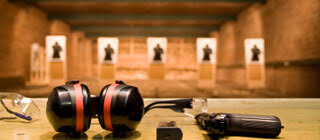What to Bring

What to bring to the Idaho Enhanced Concealed Carry Class is always a mystery, especially for new concealed carry students. This is a comprehensive list of what to bring and what to expect.
The Idaho Enhanced Concealed Carry Class requirements are simple.
- Attend an 8-hour class about self-defense.
- 6-Hours Classroom
- 2-Hours Range
- Attend a legal lecture about using deadly force in Idaho by an attorney or qualified law enforcement officer.
- You should take a Basic Pistol class if you are unfamiliar with your gun.
- Shoot 98 rounds of ammunition.
- There is no written test to pass.

This is A Two Day Course!
Prerequisites:
— MUST BE 18 YEARS OLD —
- NONE. It is assumed you know how to use your gun. This is not a basic gun class.
- If you are new to guns: It is highly recommended that you attend formal gun training such as the Idaho Pistol Essentials 101 Course, or the Women’s Only Workshop Pistol 101 Course.
- Between 18 and 21, you will receive a standard Idaho Concealed Carry Permit. When you turn 21, it can be upgraded to the Idaho Enhanced Concealed Carry Weapons Permit.
- To jump ahead on Idaho Gun Laws, visit the Official Idaho website.
Adherence to the primary safety rules must always be followed.
- Keep the Firearm Pointed in a Safe Direction.
- Keep the Firearm Unloaded Until Ready to Use.
- Keep Your Finger Off The Trigger Until Ready to Shoot.
- Know Your Target and Beyond.
- No Drugs, Alcohol, nor Cannabis are Allowed At The Range.
What to Bring
Equipment:
Day 1: Classroom – Saturday
- Notepads, pens, paper, highlighter.
- A personal revolver or pistol of any caliber, cased, secured, and free of ammunition.
- Strong-side Holster, Appendix Holser, or Holster Purse: Preferably the one you intend to use when you carry concealed.
- No Serpa Holsters Allowed
- Training Cartridges (Dummy Rounds): At least 5 Training Cartridges in the correct caliber are needed for this class.
- Can be found at local sporting goods stores or online.
- Suitable Eye Protection. This can be wraparound eyewear, polycarbonate lenses, or non-shattering prescription glasses.
- Suitable Ear Protection. We recommend electronic noise canceling earmuffs but earplugs are acceptable.
- Approxiament Length: 6 Hours
Day 2: Range Day – Sunday
- A personal revolver or pistol of any caliber, cased, secured, and free of ammunition.
- Strong-side Holster, Appendix Holser, or Holster Purse: Preferably the one you intend to use when you carry concealed.
- No Serpa Holsters Allowed
- Training Cartridges (Dummy Rounds): At least 5 Training Cartridges in the correct caliber are needed for this class.
- Can be found at local sporting goods stores or online.
- Suitable Eye Protection. This can be wraparound eyewear, polycarbonate lenses, or non-shattering prescription glasses.
- Suitable Ear Protection. We recommend electronic noise canceling earmuffs but earplugs are acceptable.
- Range Fees, if any, are the responsibility of the student and are not included with the course registration.
- Check the weather report on the day of class and bring appropriate clothing.
- Wear appropriate clothing for the weather.
- Bug Spray for the critters.
- No V-Neck Shirts or Open-toed shoes.
- Head covering if necessary.
- Sunscreen or jackets when needed.
- Suitable and Comfortable Footwear, no open-toed shoes are allowed.
- Beverages for Hydration.
- Bring snacks for breaks. Snacks – Are allowed at the range – snacks are not allowed on the firing line.
- 150 Rounds of Quality, store-bought ammunition (no tracers, steel, or reloads allowed).
Optional but highly recommended:
- Knee Pads – for range day and private shooting drills afterward.
- Small Personal Canopy during the summer season when temperatures are expected to be high.
- Folding chair and a small folding table to create your own workstation (bench).
- Approxiament Length: 4 Hours.
